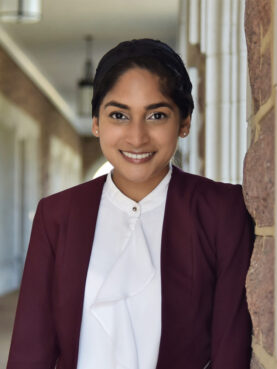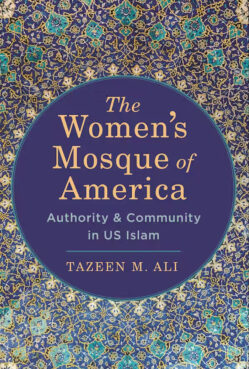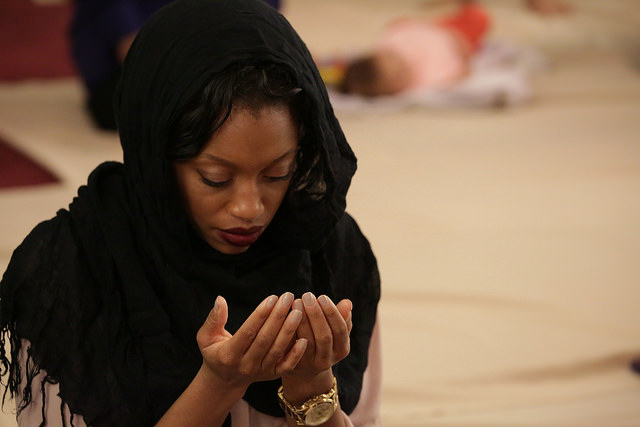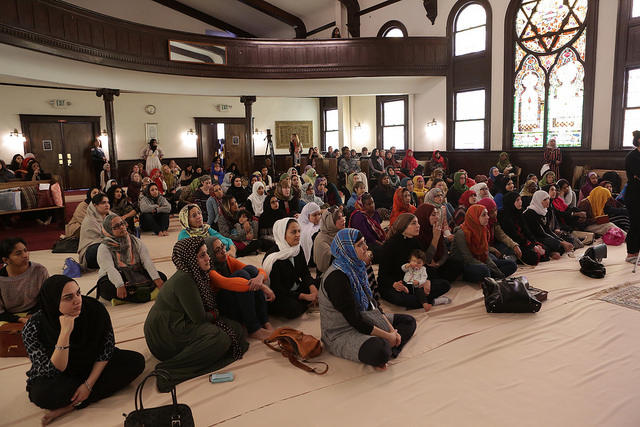LOS ANGELES (RNS) — Tazeen M. Ali was a graduate student in Boston when she first learned about the opening of the Women’s Mosque of America in Los Angeles, believed to be the nation’s first women-only mosque.
Ali recalls the social media debates that ensued around the mosque’s 2015 opening, with people arguing over the Islamic legality of woman-led prayers as well as news coverage about “Muslim women ‘fighting back’ against the patriarchy.”
These media narratives informed Ali’s assumptions that the mosque was a “radical space” made up of younger women who carried traumatic and negative experiences from other Islamic worship centers.
Ali would later learn it was much more than that.
In her recently released book, “The Women’s Mosque of America: Authority & Community in US Islam,” Ali explores how Muslim women without formal Islamic training have been able to cultivate religious authority in the congregation. The Women’s Mosque of America, writes Ali, “demonstrates the dynamism of Islam and the women who interpret it, who approach the Qur’an as a tool to resist social hierarchies, build community, and empower themselves.”

Tazeen M. Ali. Photo courtesy of Washington University
At the space, Ali — an assistant professor of religion and politics at Washington University in St. Louis — found a multiracial and multigenerational group of women, some who also occupied active roles in conventional mosques where they prayed and participated in community with men. The women’s mosque, as Ali wrote, hosted monthly jumah for Muslim and non-Muslim women, girls and boys under 12 years of age. While for some, the women’s mosque was the only space they were a part of, Ali learned it also functioned as a “complementary space” for many who belonged to other worship communities.
Ali highlighted how the mosque’s founder, Hasna Maznavi, a comedy writer, explicitly stated that her vision for the Women’s Mosque of America was “rooted in Muslim history” and the Muslim women’s leadership and women-only mosques that have existed for centuries.
Lawyer Sana Muttalib, WMA’s former co-president, credited the Quran for her understanding of Islam as a “gender-egalitarian religious tradition” and her motivation for immersing herself with the women’s mosque, Ali wrote.
Alongside Maznavi and Muttalib, both millennials, were preachers like Gail Kennard, a former journalist in her mid-60s who served as president of the oldest and one of the largest African American architectural firms in LA.
Ali spent a summer in Los Angeles in 2017, making connections with WMA members during Ramadan social events and after jumah while socializing around a halal food truck outside of the mosque. She interviewed more than 20 congregation members at coffee shops and cafes around LA and some at the Islamic Center of Southern California, one of the area’s largest mosques that WMA members also attended.
To Ali, it was interesting to see the women’s mosque not as an escape, but as something that added to the members’ spiritual lives. Their participation wasn’t reactionary or politically driven, and it didn’t come from a place where they sought to “make a stance” or “revolutionize anything.”
“They didn’t see themselves as doing anything radical,” Ali told Religion News Service. “They really saw it as this lovely organic space that seemed like a very natural thing to be a part of.

“The Women’s Mosque of America: Authority and Community in US Islam” by Tazeen M. Ali. Courtesy image
“It was different from their other mosque experiences that they weren’t necessarily critical of. … They weren’t necessarily coming from these traumatic places,” Ali added.
Ali was drawn to the mosque after spending hours on YouTube watching videos of their sermons. Ali found the khutbah (congregational prayer) and post-jumah discussion circle were designed to be intimate communal experiences that mark the WMA as a safe space for women.
She opens her book with an anecdote of Kennard as the designated khateebah (female preacher) that month in August 2015, as she spoke on the ways Prophet Muhammad’s 12 wives were role models for all Muslim women. Kennard believed polygamy was oppressive to women and noted that Muhammad’s multiple marriages came after the death of his first wife, Khadijah, to whom he was monogamously married for 25 years.
As Kennard turned to Islamic scripture to address her ethical concerns, she understood Muhammad’s wives to be “divinely ordained to speak as religious authorities in the early Muslim community,” Ali wrote. To Kennard, the marriages were the only way Muhammad could “legitimize his close access to the women who had been chosen by God to be his disciples.”
Kennard highlighted that none of Muhammad’s wives after Khadijah bore him any children who survived past infancy, which, Ali wrote, served her as further confirmation that “there was a higher, divine purpose to their marriages.”
At the beginning of her sermon, Kennard said she previously only considered Muhammad’s first wife as an empowering role model for Muslim women, but by the end, she advised the congregation to carry on the wives’ legacy of using their voices to spread religious knowledge.
“Their spirit is reaching across the centuries to remind us that we can do more than we think is possible. If they could do what they did in their time, why not us and why not now?” Kennard was quoted saying in her sermon.

A woman prays during Friday Muslim prayers on Jan. 30, 2015, in what would become the Women’s Mosque of America in Los Angeles. Photo courtesy of Alexa Pilato
Ali also touched on ways the WMA preachers used “scriptural principles of God’s compassion” when addressing social issues such as Black Lives Matter, environmental justice and mass incarceration. Through her interviews, Ali learned that some congregants felt the women’s mosque carried an “added layer of religious legitimacy” because leaders there discussed social issues in ways they didn’t see their respective mosques doing.
“One of the major appeals to them was that this mosque was engaging with current social justice movements and issues in a way that they felt was missing in their other communities,” Ali told RNS.
Ali mentioned an interview with a WMA member who was struck when their male preacher at their regular mosque didn’t address the election of President Donald Trump during Friday prayer that week in 2016.
“Muslims who felt very unsafe were looking to religious leaders to open up some kind of space to process that, and they were struck that that didn’t happen in those communities,” Ali said.
Ali hopes her book can show the U.S. “should be taken seriously as part of the Muslim world,” as opposed to Muslims in the West only being seen as a “minority context that exists on the margins.”
By doing so, Ali said American Muslim women can be taken seriously as “these meaningful actors who are contributing to the Islamic interpretive tradition as it’s unfolding.”
“They’re reading scripture and applying it to our understandings of how we should think about domestic violence, sexual violence and gender-based violence,” Ali said.
The Women’s Mosque of America, Ali said, “has global implications for how we study Islam.”





